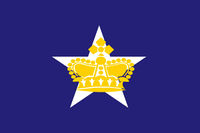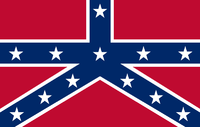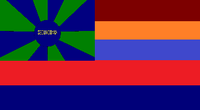Socialist Republic of Sterling-Charcot
"Sterling-Charcot" redirects here. For other usages of Sterling or iterations of the similar micronations see Sterling (disambiguation)
Socialist Republic of Sterling-Charcot | |||||||
|---|---|---|---|---|---|---|---|
|
Flag | |||||||
| Motto: Forever the People's | |||||||
| File:Charcot Island, Antarctica | |||||||
| Capital | Charcot City, 30th April District | ||||||
| Largest city | Charcot City | ||||||
| Official languages | English, Secundomian | ||||||
| Demonym(s) | Sterling-Charcotian | ||||||
| Government | |||||||
• Premier | Parker I | ||||||
| Establishment | April 30, 2016 | ||||||
| Population | |||||||
• (No year-round population) census | 0 | ||||||
| Currency | USD ($) | ||||||
| Time zone | UTC -6 | ||||||
| |||||||
Constituent Republic of the FSSR | |||||||
The Socialist Republic of Sterling-Charcot (pronounced [stərliːŋ tʃɑːrkɔːt]) (also known as SRSC or Sterling-Charcot) is a constituent republic of the Federation of Secundomian Socialist Republics located in Antarctica. Sterling-Charcot has a long micronational history dating back to the Kingdom of Sterling. Since its foundation as a Kingdom in 2010, Sterling-Charcot has gone through many iterations as both a member of other micronations in the Secundomian Sector or as an independent nation in its own right. Sterling-Charcot has almost always been under exclusive control of micronationalist Parker I, operated as a personal project of his beside the larger nation of Secundomia.
Sterling-Charcot is a Single-Party state ruled by the Maoist-Worker's Party of Secundomia. Administered by the central government of the FSSR, Parker I has been Premier of Sterling-Charcot since 2016. Charcot City is the de jure capital of the republic, but contains no citizens as the FSSR lacks the resources to maintain a base on Charcot island. Hanover, Eastern Secundomia acts as the de facto seat of power for Sterling-Charcot.
Before the rise of the FSSR, Sterling-Charcot's predecessor, the Kingdom of Sterling was an extremely active micronation on the MicroWiki sector. King Parker I conducted aggressive foreign policy on behalf of Sterling and her sister state the Republic of Secundomia that earned the micronation a reputation firmly committed to simulationism and prone to interventionist wars. While Sterling-Charcot remains a simulationist project, it is now largely an isolationist micronation with little influence on intermicronational affairs since 2012.
Etymology
Sterling-Charcot is named after the Kingdom of Sterling and Charcot Island, the older micronational kingdom and the island that constitutes the republic. In turn, the Kingdom was named for the boy's name meaning "genuine" or of "high quality," also for the Sterling grade of silver. This was chosen by Parker I to represent the Kingdom's high worth.

Charcot Island is named by Jean-Baptiste Charcot to honor his father Jean-Martin Charcot. However, like Gravois, the name of the republic is pronounced in a corrupted American accent as [tʃɑːrkɔːt] rather than the original French [ʃaʁko]. The hyphenation of Sterling-Charcot was chosen by the FSSR to reflect a distinction between the republic and the legacy of the Sterling Monarchy.
History
Charcot Island was discovered by an expedition lead by French polar scientist Jean-Baptiste Charcot in 1910. It was named Charcot Land. Australian polar explorer Sir Hubert Wilkins proved the insularity of Charcot Land in 1929. Charcot Island was connected to the mainland of Antarctica and the Wilkins Ice Shelf by an icebridge. This collapsed rapidly in 2009, shattering into hundreds of icebergs.
Foundation of the Kingdom of Sterling
On January 26, 2010, co-president Parker I of the Republic of Secundomia founded the Kingdom of Sterling as a side-project to Secundomia. Sterling was founded as an absolute monarchy, lead by the King of Sterling. Proclaiming himself King, Parker I proceded to claim all of the ice in the Arctic Ocean, organizing this claim as the Grand Duchy of Iceia additionally proclaiming himself Grand Duke. Spencer I was crowned Prince of Sterling. Rather than claiming land, the Kingdom of Sterling was entirely oceanic, relying on shifting ice sheets to provide the basis for a country. Despite this claim, the Sterling Monarchy never resided in the Arctic Ocean, ruling out of Middle Secundomia.
On January 28, 2010, Parker I expanded the claims of the kingdom. Sterling claimed the southern hemisphere of Pluto, bordering the Aerican Empire. This territory was organized as the Territory of South Plutopia. Sterling additionally claimed the planet of Mercury as the Mercury Territories and 243 Ida. On January 29, King Parker I split the Mercury Territories into North Mercury Territory and the Duchy of South Mercuria. Spencer I was awarded the title Duke of South Mercuria. The King also reorganized Iceia, carving a small territory out of the North Pole as the city of Northland in the new capital territory of Sterling, the "King's State."

On February 17, King Parker renounced his claim to the Grand Duchy of Iceia, transferring it to vassal and new Grand Duke Rahim I. Spencer I also transferred the Duchy of Southern Mercuria to Duke Ibrahim I. Spencer retained his title as the Prince of Sterling. Shortly after this restructuring, Sterling laid claim on Charcot Island on February 20, incorporating it as the Duchy of Charcot. Sterling submitted an application to join the Antarctic Micronational Union, surrendering its extraterrestrial claims in the process. Rather than lead an independent duchy in the south of Mercury, Duke Ibrahim I also renounced his title and was awarded a new peerage as the Duke of Charcot.
Relationship to Secundomia and MicroWiki
The structure of the Monarchy was peculiar to micronationalism. Parker claimed absolute authority over Sterling yet also claimed that Sterling was a "vassal" of Secundomia. This government structure was inspired by the government of Andorra, where the President of France is simultaneously Crown Prince. Secundomia's authority over Sterling was nominal at the time, but Parker I was the most prominent figure in both countries in the intermicronational stage. While others were elected President in Secundomia, Parker almost always represented both nations in the OAM and the MicroWiki community.

The Kingdom of Sterling was also more aggressive diplomatically than Secundomia, due in part to Secundomia's system of checks and balances on the foreign policy powers of its President. This lead to a perception in the community that Sterling was Secundomia's puppet, acting in proxy of the Republic. This perception is partially true, especially after the passage of Secundomian Resolution 1,[1] however Parker's actions with Sterling didn't always reflect the opinions of the remaining members of the Secundomian Government. Most in Secundomia, including the government, lacked basic foreign affairs knowledge and focused largely on domestic matters. Parker did not share this isolationist bend, and Sterling remained a more outgoing country.
Austenasian Civil War

Sterling became prominent in the MicroWiki community for its outspoken support of the Carolinian rebels in the Austenasian Civil War. After the ascension of Emperor Esmond III to the throne in Austenasia, Princess Caroline disputed the claim. King Parker I believed the Carolinian argument that secession could not be abrogated by acts of parliament. After the failure of the Vestry Conference and the outbreak of war in Austenasia, the Kingdom of Sterling officially issued a declaration of war on the Empire of Austenasia.
Sterling's entrance to the war alongside the Socialist Union of Nemkhavia and Pristinia became a hotly debated subject on MicroWiki. The St.Charlian Observer published an article critiquing foreign interference in Austenasia singling out Sterling's involvement in particular. In response, the AMU suspended Sterling's membership. Sterling withdrew from the conflict a day later, proposing the idea of shared monarchs to resolve the conflict. King Parker I, a staunch defender of simualtionist intermicronational warfare, rebuked speculation that his withdrawal was motivated by public criticism.

Ten days later, on behalf of the Aegis Alliance, Zonian Confederacy President Nicholas Woode-Smith urged Secundomia to enter the conflict in support of Princess Caroline. Secundomian President Spencer I declined. To save face with their close allies, King Parker I (then foreign minister of Secundomia) signed the Kingdom of Sterling onto the Allied Carolinian Coalition, reentering the war. However, by the time Sterling officially joined the coalition on March 20 the Zonian Confederacy had just withdrawn. Sterling maintained its declaration of war until April 1 when it withdrew from the collapsing coalition soon followed by NottaLotta Acres. Crown Prince Jonathan of Austenasia thanked Sterling for withdrawing.
While Parker attempted to mobilize the Sterling military for conflict including of training exercises conducted on a shared base in Middle Secundomia, Sterling never saw combat during the Austenasian Civil War. Sterling and Secundomia maintained diplomatic support for Caroline and the South Kilttown rebels until their defeat. Despite never seeing combat, the Austenasian Civil War had a significant impact on both micronations reputations in the MicroWiki community. Parker embraced the community perception of his aggressive and cavalier strategies of diplomacy and aligned with other controversial and young micronations of the time.
After the war, Sterling was largely inactive internally and became even more significantly a proxy for Secundomia's involvement in the micronational community, in particular the OAM. After President Luke of Secundomia entrusted Parker I to run foreign affairs for Secundomia, King Parker considered Sterling to have "outlived its usefulness" and decided to gift the Duchy of Charcot to Secundomia as the Colony of Sterling, dissolving the Grand Duchy of Iceia and King's state and abdicating from the throne.[2] Consequently, Sterling left the OAM and was replaced by the Republic of Secundomia.[3]
Colonial Period
Parker I was assigned as protector of Sterling by President Luke on July 18, 2010. He left the office when he was elected vice president of Secundomia on August 1, 2010. President Luke did not appoint a new protector but Parker I remained de facto in charge of the colony until October. Internal activities during this period were limited as most of the focus was directed at the Republic, who were constitutionally bound to avoid intervention within the Colony.[4] After he was elected President of Secundomia, Parker I appointed J of Sterling protector of the colony of Sterling.[5] J had been a relatively inactive citizen of Secundomia and Parker felt that giving him a seat of power might encourage him to be more active.

J of Sterling remained largely inactive as leader of the colony. He left Secundomia after relocating in 2011, but de jure retained the position of protector. Sterling remained inactive and Parker admitted that the purpose of the colony had "become muddled."[6] The question of Sterling was brought up upon Secundomia's entrance to the Eran Federation in 2012. Parker I, now Prime Minister of Eran, appointed himself protector once again.
Post-colonial period
On June 14, 2012, Prime Minister Parker I of Eran renounced Secundomia's (and thus Eran's) claims to Charcot Island. Parker created the Republic of Sterling to independently govern Charcot Island. Parker appointed himself Military President of Sterling. The new government was still largely dependent on Secundomia and Eran, with Secundomian Media the largest economic foundation in the micronation. In 2013 the Republic of Sterling merged with Res Publica Tergumterra a micronation formerly a department in the Slinky Republyc that also consisted exclusively of Parker I. The new Republic of Sterling and Tergumterra was largely inactive and mainly operated as a historical vessel for Sterlingish and Tergumterran culture.

Sterling was once again rendered subject to Secundomia in the May 13 coup where Parker I combined Sterling, Tergumterra and Secundomia into one nation, the Third Kingdom of Secundomia. The Principality of Sterling was again recognized as a vassal of Secundomia but with much less independence than the Kingdom of Sterling. The Third Kingdom was an absolute monarchy and Parker I occupied the place of both King of Secundomia and Prince of Sterling. The Worker's Party uprising in the Kingdom of Secundomia did not affect Sterling, however. The Revolutionary Commission in the Democratic Republic of Secundomia did not recognize Sterling as a part of the Republic. Parker I abdicated his position as Prince of Sterling as a result of the revolution, so Sterling entered an interregnum.

FSSR
The 2016 revolution in Secundomia resulted in significant changes for Sterling. The Maoist-Worker's Party of Secundomia seized power in both Sterling and Tergumterra. Sterling was reorganized as a constituent republic of the Federation of Secundomian Socialist Republics. The principality was renamed as the Socialist Republic of Sterling-Charcot. Parker I was appointed Premier of Sterling-Charcot by the MWPS which sought to reorganize the SRSC as a totalitarian socialist state. Sterling-Charcot was split into three districts, the capital 30 April District in the north consisting of Charcot City and the area around the Marion Nunatuks, Charcot District in the center and west coast of the island including Cape Byrd, and Sterling District along the east coast in the area of the former Wilkins Ice Shelf.
Politics and Government
This section is empty. You can help by adding to it. (September 2022) |
Geography

Sterling-Charcot is by far the largest Republic in the FSSR with an area of 995 square miles. The micronation is located to the west of the Antarctic Peninsula. It is surrounded by the Bellinghausen Sea and lies 55 nautical miles west of Alexander Island and 31 miles north of Latady Island. Notably, Charcot Island is misplaced on the mapping service Google Earth by 11 nautical miles.[7]
Sterling-Charcot is broken into three districts. The northernmost district is the 30th April District, named for the date of the establishment of the FSSR. The 30th April District contains Charcot City, the capital of the Republic. The capital is located to the northwest of the Marion Nunataks which are the most striking feature on the island. While all of Sterling-Charcot is mountainous, only the Marion Nunataks appear uncovered by ice year round.
To the south of the Marion Nunataks is Charcot District. Charcot District consists of the ice-covered mountainous interior of the republic and the western coast of the island along Bellingshausen Sea. Charcot District has access to the Ducklow Inlet, a small treacherous bay that is one of the key access points to Sterling-Charcot.[8] This inlet is not to be confused with Port Charcot which is located on Booth Island, an area not claimed by the FSSR. Charcot District also contains Cape Byrd, a prominent feature of Charcot Island visible to passing vessels.
Sterling district covers the eastern and southern coasts of the island. This is the most barren and inaccessible part of Sterling-Charcot. Much of the sea in this area is marred by icebergs from the collapsed Wilkins Ice Shelf which once connected to the eastern coast of the island.
Climate
| Climate data for Socialist Republic of Sterling-Charcot, Federation of Secundomian Socialist Republics (Base San Martin weather station 371 km away) | |||||||||||||
|---|---|---|---|---|---|---|---|---|---|---|---|---|---|
| Month | Jan | Feb | Mar | Apr | May | Jun | Jul | Aug | Sep | Oct | Nov | Dec | Year |
| Average high °C (°F) | 5 (41) |
4 (39) |
2 (36) |
0 (32) |
-2 (28) |
-6 (21) |
-8 (18) |
-8 (18) |
-5 (23) |
-2 (28) |
1 (34) |
4 (39) |
−1.25 (29.75) |
| Average low °C (°F) | -1 (30) |
-3 (27) |
-5 (23) |
-8 (18) |
-9 (16) |
-13 (9) |
-17 (1) |
-18 (-0) |
-15 (5) |
-10 (14) |
-5 (23) |
-3 (27) |
−8.58 (16.56) |
| Average Precipitation mm (inches) | 20 (0.79) |
30 (1.18) |
62 (2.44) |
60 (2.36) |
78 (3.07) |
40 (1.57) |
59 (2.32) |
60 (2.36) |
61 (2.4) |
43 (1.69) |
40 (1.57) |
20 (0.79) |
47.75 (1.8799) |
| Source: MeteoBlue | |||||||||||||
Flora and Fauna

Sterling-Charcot is home to a colony Adélie penguins. The significant penguin colony was confirmed near the Ducklow Inlet in the Charcot District.[9] Other terrestrial fauna are largely clustered around the Marion Nunataks in northern Sterling-Charcot. The ice-free terrain of the region is extremely limited, with low species diversity but native flora and fauna do survive on the seemingly barren rocks. Mites, nematodes and tardigrades make up the animal species inhabiting the Nunataks. Liverworts, mosses and lichens grow on the rocks. Unique to Antarctica, Sterling-Charcot is not home to predatory arthropods or springtails due to the extreme isolation of the ice-free terrain.[10] This unique biome requires careful observation and protection to prevent destabilization.
External links
This section is empty. You can help by adding to it. (September 2022) |
References
- ↑ Secundomian Resolution 1 - MicroCommons
- ↑ Parker I, "Folding of Sterling into Secundomia," Secundomian Email Server, 18 Jul 2010.
- ↑ OAM Forums - Membership Sub-Forum Post by Parker I
- ↑ Preamble - Constitution of Secundomia
- ↑ Parker I, "Hey what's up Secundomia? (PLEASE READ EVERYTHING, IMPORTANT)" Secundomian Email Server, 28 Dec 2010
- ↑ Parker I, "Daily Newsletter: Secundomia." 27 Feb 2011
- ↑ https://mallemaroking.org/ships-and-antarctic-charts/
- ↑ https://blogs.ei.columbia.edu/2019/11/27/ducklow-inlet-charcot-island/
- ↑ https://blogs.ei.columbia.edu/2019/11/27/ducklow-inlet-charcot-island/
- ↑ https://www.cambridge.org/core/journals/antarctic-science/article/abs/terrestrial-biota-of-charcot-island-eastern-bellingshausen-sea-antarctica-an-example-of-extreme-isolation/9963099BA5191B65EBFBB3041B546B96
